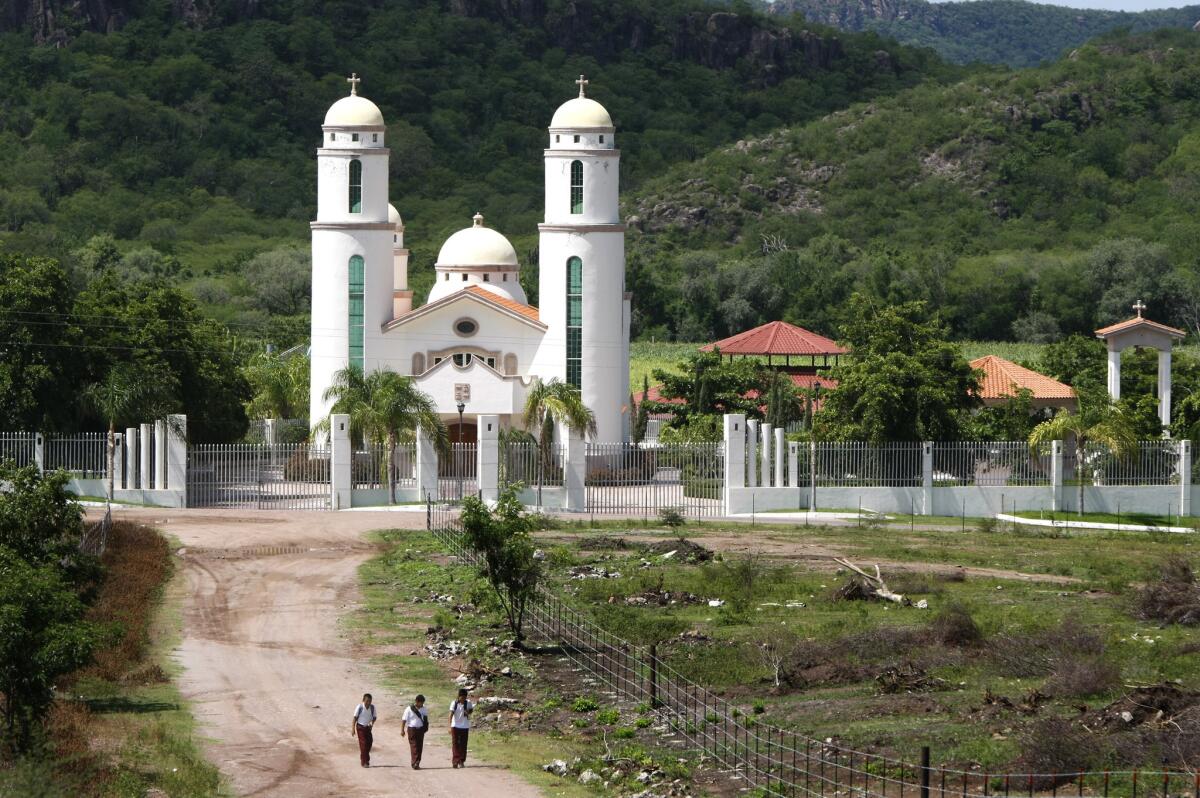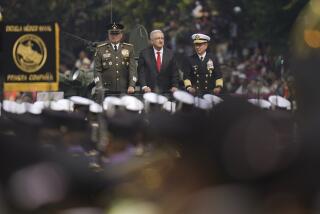Suspicion in Mexico’s Sinaloa cartel

Reporting from Calexico, Calif., and Badiraguato, Mexico - The towering iron gates opened onto a palm-lined driveway that led past the family church, a twisting water slide and two man-made lakes, one stocked with fish, the other with jet skis.
With its soaring twin bell towers, each topped by a cross, the estate in the emerald hills outside Culiacan, Mexico, had an almost surreal grandeur. It reminded Carlos “Charlie” Cuevas of Disneyland, without the smiles.
Cuevas, a drug trafficker from Calexico, Calif., had been summoned there by Victor Emilio Cazares, allegedly a top lieutenant in the Sinaloa cartel. Cazares was said to be upset by a rash of recent drug seizures by U.S. authorities.
In one of them, police had raided a stash house in Paramount, southeast of Los Angeles, and confiscated nearly 455 pounds of cocaine, worth about $3.3 million.
Cuevas had come under suspicion, and not only because he handled the shipment. Raised in California, he was an outsider. He couldn’t claim Sinaloan roots. The boss and his heavily armed cronies would make fun of his American-accented Spanish and call him a derogatory term for Mexican Americans.
Cuevas’ drivers and lookouts were also suspect. He had been ordered to bring them to Mexico for questioning. He hadn’t.
Cuevas feared his boss — he’d guzzle Pepto-Bismol for his frequent gut eruptions — but this time he stood firm.
“I’m so sure it’s not one of my guys that you can kill me if it’s one of them,” Cuevas said.
In the shadows
The confrontation reflected the frustrations of a cartel in confusion. Cocaine shipments were being seized all over the U.S.: by New Jersey and New York police, California Highway Patrol officers, Oklahoma state troopers and others. The array of agencies was a cover for the main force behind most of the busts: the Drug Enforcement Administration.
Cazares didn’t know it, but he was a top target in one of the largest DEA investigations ever of a Mexican organized crime group. Operation Imperial Emperor was peeling back layers of a drug distribution ring with hundreds of truckers, packers, money couriers and stash house operators across the U.S.
Local police made arrests while DEA agents stayed in the shadows, piecing together evidence and listening to cellphone chatter.
Keeping the DEA’s involvement quiet was key.
A major trafficking suspect like Cazares didn’t sweat local busts, but a federal investigation would put him on alert. Wiretaps would go silent, evidence would disappear, suspects would flee.
The DEA was allowing the drug pipeline to continue running so agents could expand their target list. There would be busts and seizures of drugs and money, but no knockout punch.
The government was trying to bleed the organization to death.
It wouldn’t be easy. The cocaine economy gushed millions of dollars a week in revenue for a reputed kingpin like Cazares, whose contacts reached from Colombia to the South Bronx. Cocaine purchased from South American producers for about $3,600 a pound was sold for $7,200 in Los Angeles and $9,000 in New York.
The biggest expense was shipping. Cuevas earned about $250 a pound moving the cocaine across the U.S.-Mexico border to distribution hubs in the Los Angeles area.
Trucking cells charged as little as $250 a pound for shipments to the East Coast. By air, a pilot from Carlsbad, John Charles Ward, charged $450 per pound.
The Sinaloa cartel bosses, unlike the Colombian traffickers of the past, didn’t control the entire distribution system. Cazares allegedly partnered with local criminal groups — Orange County gang members, Italian Canadian mobsters, Dominicans in the Northeast — to get the drugs to users.
Profit margins at the wholesale level were staggering: One ton of cocaine, after transportation costs, could yield $5.4 million. Over three years, Cazares had allegedly smuggled an estimated 40 tons into the U.S., generating more than $200 million in profit.
And that created another logistical challenge: getting the money back to Mexico.
That was handled by Cazares’ sister, according to federal agents and an indictment filed by Los Angeles County prosecutors. Blanca, a society-page fixture in Culiacan nicknamed “the Empress,” allegedly controlled currency-changing houses in Tijuana and other border cities, where drug proceeds sent via courier from Southern California were converted to pesos. The cash was divided into amounts of less than $10,000 and deposited in banks along the border.
Blanca Cazares could withdraw or transfer the funds at will, distributing profits to associates, distributors and her brother.
Gentleman rancher
In the mid-1990s, Victor Cazares was an illegal immigrant with big dreams living in a run-down cottage in the city of Bell, southeast of Los Angeles.
When police arrested him with a baggie of drugs, he said he worked as a $50-a-day landscaper and admitted a fondness for cocaine. He vowed to quit.
“The defendant’s plans are to work and become a Christian,” his probation officer wrote in his report.
By 2005, Cazares had moved back to his homeland, where he kept one of his promises by building a church on his 25-acre estate in Mexico’s historical drug-trafficking heartland of Badiraguato, outside Culiacan. He cultivated a reputation as a generous gentleman rancher, and the Mexican government gave him more than $129,000 in subsidies to raise cattle.
Cazares trucked in locals to harvest his fields of tomato, pepper, eggplant and squash, paying them twice the normal wage.
“He was a good neighbor. He gave people work. He’d pass by, wave a greeting,” said Guadalupe Rubio, who lives in a village near the hacienda.
Cazares allegedly was a primary distributor for Joaquin “Chapo” Guzman, the Sinaloa cartel’s leader and the most wanted trafficker in the world.
Yet in many ways, he acted more like a vice president of shipping for a U.S. manufacturing firm, obsessing over logistics and cost control.
While cartel soldiers waged war in Mexican border cities, killing hundreds of rivals and police officers, workers in the U.S. primed the drug pipeline in anonymity, driving small cars, renting modest houses and leading low-profile, generally peaceful lives.
Spilling blood on U.S. streets was avoided. Disputes were taken care of in Mexico, where discipline or vengeance could be meted out in the lawless countryside outside Culiacan.
Meet Gato
By 2006, the money was pouring in, and Cazares tried to track every penny, the DEA investigation found. He called key associates in the U.S. at all hours and took weekly inventories of cocaine shipments moving across the country.
When authorities intercepted cocaine or money, Cazares demanded that subordinates produce proof of seizure: news clippings, police reports, court documents. If the seizure resulted from good police work, the load was written off as a cost of doing business. If it was deemed the fault of the distributor, Cazares demanded compensation.
Determining fault sometimes required extreme methods, or at least close interrogation. In such cases, Cazares called meetings at his estate, as he did after the March 2006 bust near Los Angeles.
Cuevas had arranged delivery of three cocaine loads from Mexicali to a distribution cell in Paramount. The cell was overseen from Mexico by a man known to his subordinates only as Gato, Spanish for “cat.”
A few hours after the delivery, police raided the cell’s stash house.
Eligio “Pescado” Rios, who ran the stash house, fled to Mexico to avoid arrest. Once across the border, he was captured by cartel enforcers. Believing he might have caused the bust through carelessness or deliberate betrayal, they tied him to a bed and beat him for several days.
Afterward, Cazares was no closer to understanding why the raid had happened. So Cuevas was summoned for questioning. Perhaps the answers would help determine who should pay for the seized drugs and whether anyone else deserved a beating, or worse.
Walking through Cazares’ mansion, Cuevas marveled at the gleaming glass living-room floor that sat over an indoor-outdoor pool. Cazares took special pride in parading his dancing horses, and children could frolic in a playground filled with swing sets and climbing structures.
Cazares and Cuevas were joined by a third man who wasn’t introduced and who remained silent.
Cazares began grilling Cuevas about the Paramount bust, suggesting that someone from his cell had been followed or had turned informant.
He said that according to Gato, Cuevas’ crew was at fault.
Cuevas blamed Gato.
At which point, Cazares introduced the silent man next to him: Gato.
A heated argument ensued.
Cuevas’ drivers had delivered the drugs, but Gato’s stash house operator had received the shipment. Neither man wanted to be on the hook for $3.3 million.
Cazares eventually stepped in.
He seemed impressed with Cuevas’ mettle. After all, Cuevas had traveled to Sinaloa knowing he might not return, and he’d stood up for his crew, even the ones too frightened to travel with him.
In the end, Cazares decided not to impose any punishment. It was the practical, business-over-bloodshed approach that exemplified the cartel’s distribution side. He needed Gato and Cuevas to continue working together, to keep the drugs flowing. And Cuevas still owed him money for past seizures.
Intimidation did have its place, however. Before Cuevas was allowed to go home to California, he was shown the room where Rios had been beaten. The mattress was still bloody.
Time to move
When Cuevas returned to Calexico, the DEA resumed its surveillance of him. For more than a year, the operation had provided valuable intelligence, but now agents worried that their cover had been blown.
A car dealer in San Diego who fixed the brakes on Cuevas’ BMW had alerted him that agents had installed a tracking device in his car.
Fearing that Cuevas would flee the country — he had been house-hunting in Culiacan — the task force decided to move in. On the morning of Jan. 20, 2007, a SWAT team broke down Cuevas’ back door and arrested him in his underwear. About two dozen members of his crew were arrested that day and in a raid the following month.
A series of sweeps targeted other players in the supply chain, from South Gate to the South Bronx. In all, authorities charged 402 people, seized 18 tons of cocaine and marijuana and $51 million in cash and property during the 20 months of Operation Imperial Emperor.
Cuevas pleaded guilty to drug distribution and conspiracy charges, testified against some of his former associates and was sentenced to 13 years in prison — much less than some other defendants.
As for Cazares, a federal grand jury indicted him in February 2007. Mexican federal agents spotted him and his family in downtown Culiacan later that year. But he was protected by 20 heavily armed bodyguards, and authorities backed off.
Mexican soldiers descended on his estate a few months later, but Cazares apparently had been tipped off. Three men were seen fleeing over a wall. The Mexican government seized the property.
A few months later, officials gave it back for reasons that are unclear.
Still, the agents could take pride in Imperial Emperor’s achievements. Their late-night stakeouts, dumpster-diving excursions and tedious phone surveillance, conducted in a bunker-like room littered with takeout menus, had yielded significant results.
They had developed an extraordinarily detailed picture of how the cartel smuggled drugs into and across the U.S. They had disrupted its distribution system and inflicted substantial financial losses. They had laid the groundwork for a follow-up campaign, Operation Xcellerator, which resulted in 755 additional arrests.
But the sense of accomplishment was tempered by the realization that the cartel’s regenerative powers could trump even the most vigorous enforcement efforts.
When Cazares’ indictment was announced, then-DEA Administrator Karen Tandy said, “Today, we ripped out this empire’s U.S. infrastructure … and tossed it into the dustbin of history.”
More than four years later, the cartel continues pumping drugs through the Calexico border crossing.
Since Cuevas’ arrest, several other smuggling crews have sprung up, and the port is still considered one of the main entry points for cocaine on the Southwest border.
Cazares’ whereabouts are unknown. At his estate, the manicured lawns and palm-lined grounds are still carefully tended. Villagers say his mother comes by on occasion and opens the whitewashed church, which is filled with stained-glass windows and decorated with paintings of angels and a serene Jesus.
MORE: The players | Evidence, wiretaps and testimony | How the drug pipeline worked | Photos: Inside the Cartel
Part One: Unraveling Mexico’s Sinaloa Cartel
Part Two: The drug trafficker and the psychic
Part Three: Clear skies and cocaine
About this story
For several years, the U.S. Drug Enforcement Administration put the distribution side of Mexico’s Sinaloa cartel under a microscope. This series describes the detailed picture that emerged of how the cartel moves drugs into Southern California and across the United States. Times staff writer Richard Marosi reviewed hundreds of pages of records, including DEA investigative reports, probable-cause affidavits, and transcripts of court testimony and phone surveillance. He also interviewed DEA agents, prosecutors and local law enforcement officers serving on DEA-led task forces, as well as two cartel operatives convicted in the investigation. Times correspondent Tracy Wilkinson traveled to Badiraguato, Mexico’s drug trafficking heartland. The account of the meeting at Victor Emilio Cazares’ mansion there is based in part on interviews and a DEA debriefing of trafficker Carlos Cuevas.
More to Read
Sign up for Essential California
The most important California stories and recommendations in your inbox every morning.
You may occasionally receive promotional content from the Los Angeles Times.












